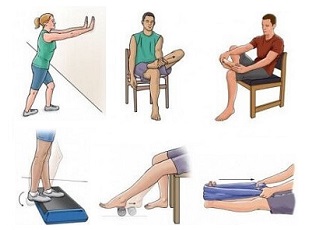- Home
- Anatomy Guide
- Gastrocnemius Muscle
Gastrocnemius Muscle
Written By: Chloe Wilson BSc(Hons) Physiotherapy
Reviewed By: FPE Medical Review Board
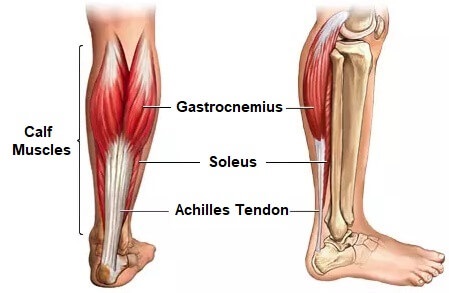
The gastrocnemius muscle is the largest and most superficial of the two calf muscles in the lower leg.
It plays a vital role with daily activities such as walking, running, and jumping, but it can also be a source of pain and discomfort if it becomes strained or injured.
This article aims to provide comprehensive information about the gastrocnemius muscle, its function, common injuries, and treatment options. Whether you are an athlete looking to prevent injury, a healthcare professional seeking more knowledge about the muscle, or someone experiencing pain in the calf area, this article is an excellent resource for you.
We will start with a general overview of the location and function of the gastrocnemius muscle and then go on to look at the common causes of gastrocnemius pain. Then, for those of you who are interested, we will look more in-depth at the specific structure and anatomy of the muscle and how it functions.
Location Of Gastrocnemius
The gastrocnemius muscle is located on the back of the calf, running between the knee and the ankle.
The gastrocnemius muscle has two heads which arise from the back of the knee, the medial and the lateral heads:
- Medial Gastrocnemius: The medial head of gastrocnemius originates from the medial femoral condyle, which is the bony bump at the bottom of the thigh bone
- Lateral Gastrocnemius: The lateral head of gastrocnemius originates from the lateral femoral condyle, which is the bony bump on the outer side of the thigh bone
The two heads merge in the upper calf region and form the bulky belly of the gastrocnemius muscle before tapering off into the Achilles tendon, which inserts into the calcaneus or heel bone.
The Achilles tendon is the largest and strongest tendon in the body, and it allows the powerful contraction of the gastrocnemius muscle to be transmitted to the foot, allowing us to push off the ground when walking or running.
Gastrocnemius forms part of a composite muscle known as the "triceps surae" along with two other muscles, soleus and plantaris.
Gastrocnemius Origin: Medial and lateral femoral condyles, knee joint capsule and oblique popliteal ligament
Gastrocnemius Insertion: Posterior surface of the calcaneus via the tendocalcaneus (aka Achilles tendon)
Nerve Supply: Tibial Nerve (S1, S2)
AKA: Gastroc, calf muscle
Gastrocnemius Function
The gastrocnemius muscle, commonly referred to as the calf muscle, is a powerful muscle that plays a crucial role in the movement of the lower leg.
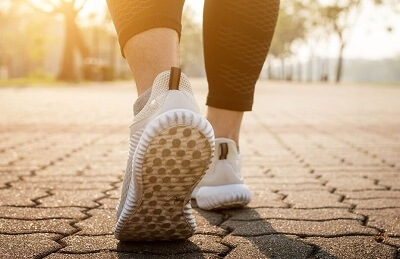
The main action of the gastrocnemius muscle is to plantarflex the ankle joint so the toes point downwards.
When standing, the gastrocnemius muscle contracts to lift our heels off the ground, allowing us to stand on tip toes.
Gastrocnemius action is essential for movements such as walking, running, and jumping, as it provides the main propulsive force to move our body forwards with each step.
Another function of gastrocnemius is to contributes to knee flexion, which means bending the knee. During movements such as running, the gastrocnemius muscle helps to absorb shock and maintain balance while the foot is in contact with the ground.
The gastrocnemius muscle also plays an important role in stabilizing the ankle joint during weight-bearing activities, such as standing, walking or jumping, particularly when changing direction. It helps to maintain the alignment of the lower leg and ankle, reducing the risk of ankle sprains and other injuries.
What Causes Gastrocnemius Pain?
Common problems that arise in the calf and cause gastrocnemius pain include:
1. Muscle Cramps
Cramp is a common cause of gastrocnemius pain where there are involuntary, painful contractions in part of the muscle.
Gastrocnemius pain from muscle cramps usually last anywhere from a few seconds to a few minutes but can, in some cases, last much longer. Calf cramps are particularly common at night.
Cramp can affect people at any age but responds well to treatment. You can find out more about gastrocnemius pain from muscle spasms and how to treat them in the calf cramps section.
2. Gastrocnemius Tear
Another common cause of calf pain is a gastrocnemius tear or strain. A gastrocnemius tear occurs when the muscle is suddenly overstretched, or repetitively overused, some or all of the muscle fibres may be torn. The tear can occur anywhere in the muscle:
- Lateral Head Gastrocnemius Tear: in the area on the outer, upper calf
- Medial Gastrocnemius Tear: in the area on in the inner, upper calf region
- Muscle Belly Tear: anywhere in the main bulk of the muscle at the back of the calf
- Achilles Tear: in the tendon that connects the calf muscles to the foot
A calf tear usually causes sudden, intense pain in the whichever part of gastrocnemius muscle is affected, and is often accompanied by swelling and bruising.
You can find out all about the causes, symptoms and treatment options for gastrocnemius tears in the Calf Tear section on our sister site.
3. Gastrocnemius Tightness
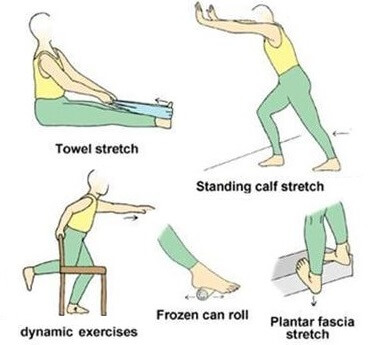
Muscle tightness in the calf region is another common cause of gastrocnemius pain. This is particularly common in women as frequent wearing of high heels often results in shortening of the gastrocnemius muscle which can limit dorsiflexion and make it difficult to walk barefoot or in flat shoes.
Gastrocnemius tightness is also a common problem in adolescents, particularly following a sudden growth spurt where bone grows faster than the muscle can stretch.
Gastrocnemius tightness is easily rectified with regular stretching. You can find a whole program of stretches for gastrocnemius tightness in the calf stretches section.
4. Achilles Tendonitis
Inflammation and degeneration of the achilles tendon is a common problem associated with gastrocnemius pain known as achilles tendonitis.
Overuse and repetitive activities such as jumping and running can overload the achilles tendon, particularly if the gastrocnemius muscle is tight. This leads to micro-tearing, inflammation and weakening of the achilles tendon, making it prone to rupture.
You can find out all about the causes, symptoms, diagnosis and treatment options in the achilles tendonitis section.
Weakness, tightness or damage to the gastrocnemius muscle can affect foot, ankle, knee, hip and back function so it is important to address any calf injuries as soon as possible.
Treating Gastrocnemius Pain
The best treatment for gastrocnemius pain will depend on the underlying cause but will usually involve a combination of:
- Rest: from any aggravating activities
- Ice: regularly applying ice help to reduce gastrocnemius pain and inflammation
- Calf Stretches: tightness in the calf muscle is often a contributing factor with gastrocnemius pain but is easily solved with calf stretches
- Calf Strengthening: Strengthening both the calf muscle is an important part of gastrocnemius pain rehab. In the calf workout section you will find loads of great exercises for strengthening the calf muscles - choose from beginners, intermediate or advanced level
Gastrocnemius Anatomy In-Depth
For those of you who are looking for more anatomical depth, let's find our a bit more about gastrocnemius anatomy.
Gastrocnemius is the muscle that forms the main bulk of the calf region on the back of the lower leg. It is a bipennate muscle, meaning it has two rows of muscle fibres, facing in opposite directions with a central tendon, resembling a feather. The shape of gastrocnemius allows for greater power.
Gastrocnemius runs from just above the knee to the heel bone, thereby crossing two joints, so it acts on both the knee and ankle joint.
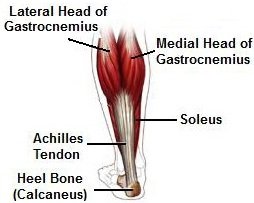
It has two heads which arise from the medial and lateral femoral condyles, just above the knee joint.
The medial head of gastrocnemius arises from behind the medial supracondylar ridge and the adductor tubercle on the popliteal surface of the femur (thigh bone).
The lateral head of gastrocnemius arises from the outer surface of the lateral femoral condyle, just above and behind the lateral epicondyle. Both heads also have an additional attachment from the knee joint capsule and from the oblique popliteal ligament.
A fleshy bulk of muscle fibres arise from each head of gastrocnemius and gradually come together (without blending), inserting into the posterior surface of a broad membranous tendon which fuses with the soleus tendon to form the upper part of the tendocalcaneus, more commonly referred to as the Achilles tendon.
This broad tendon gradually narrows and becomes more rounded until it reaches approximately 4cm above the calcaneus (heel bone) where it expands again until it inserts to the middle part of the posterior surface of the calcaneus.
Together with the soleus and plantaris muscles, gastrocnemius forms a composite muscle known as the triceps surae, one of the most powerful groups of muscle in the body. The three muscles work together to plantarflex the ankle joint i.e. pull the foot downwards.
Gastrocnemius provides a majority of the propulsive force during running, walking and jumping. It is predominantly made up of type II fast twitch fibres (white muscle fibres) so is primarily involved in fast, powerful movements rather than more passive or stabilising control.
As the gastrocnemius muscle arises above the knee, it can also flex the knee joint. However if it works over both joints simultaneously, it cannot exert full power over both joints e.g. it has more strength to flex the ankle joint if the knee is straight rather than bent.
You can also find out all about the partner muscle of gastrocnemius, soleus, the deeper of the two calf muscles.
You may also be interested in the following articles:
Page Last Updated: 05/09/23
Next Review Due: 05/09/25
